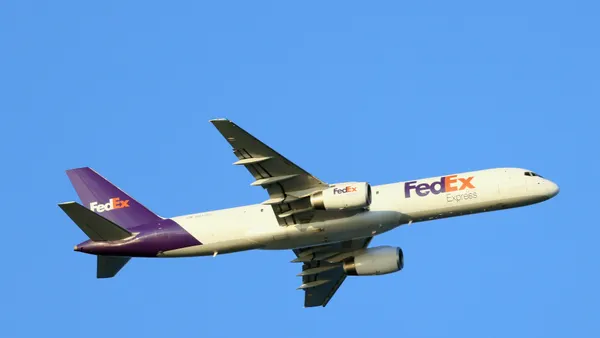Dive Brief:
- UPS will raise peak surcharges on shipments from mainland China and Hong Kong to the U.S. starting Aug. 30. The new surcharges will last until further notice, according to the carrier's latest update issued Thursday.
- The carrier's parcel surcharges are increasing nearly 30% from the existing levels in place since July 26. Freight rates are increasing by almost 14%. As of Aug. 30, U.S. Worldwide Expedited surcharges will be more than double what they were at the beginning of April. Shipments from Taiwan, Vietnam, Malaysia, Thailand, Indonesia, Singapore, Philippines, Australia and New Zealand to the U.S. are also facing roughly 30% higher surcharges beginning Aug. 30.
- UPS announced peak-season surcharges on domestic parcels on Aug. 7, one week after new CEO Carol Tomé told analysts on an earnings call the carrier wouldn't be chasing volume going forward, but rather emphasizing quality in terms of volume (and therefore revenue) and service. The domestic surcharges will run Nov. 15 to Jan. 16.
UPS peak surcharges per pound from mainland China and Hong Kong to U.S.
| Service | July 26 to Aug. 29 | Aug. 30 until further notice |
|---|---|---|
| UPS Worldwide Express Plus | $0.79 | $1.02 |
| UPS Worldwide Express | $0.79 | $1.02 |
| UPS Worldwide Saver | $0.79 | $1.02 |
| UPS Worldwide Expedited | $0.75 | $.98 |
| UPS Worldwide Express Freight | $1.59 | $1.81 |
| UPS Worldwide Express Freight Midday | $1.59 | $1.81 |
Source: UPS
Dive Insight:
China/Hong Kong airfreight rates are nowhere near their peak in May, but they have been slowly gaining altitude since early July with some hint of moderation in August, according to the TAC Index. Plus, the normal ways of contracting airfreight have been turned upside down by 2020's demand surges and supply shortages, as belly cargo from passenger flight is virtually unavailable.
UPS has adjusted China-to-U.S. surcharges several times throughout the pandemic — raising them, for the most part — as airfreight demand rises and falls. But recent comments from Tomé put surcharges in a somewhat different light.
Tome promised to operate a "better, not bigger" UPS, meaning the carrier will be selective about which volume it takes and which it leaves. Surcharges are at the heart of that selection process.
In the second quarter, UPS operating profit increased 7.4% year over year (YoY), which Tome said was largely due to international volumes — domestic profitability declined. UPS volume out of Asia grew 46.8% YoY in the second quarter.
After a meeting with executives, UBS analysts wrote that UPS is shifting down its capacity-building work — expecting the small parcel market to remain tight through next year. The international surcharge increase is more evidence of what iDrive Logistics President Glenn Gooding called an "emboldened" carrier set. FedEx announced peak season surcharge hikes soon after UPS, and USPS will temporarily raise prices in October.
All the more reason to negotiate every detail with carriers, according to Robert Martinez, founder and co-CEO, Shipware. "Nine out of 10 shippers are leaving money on the table."














